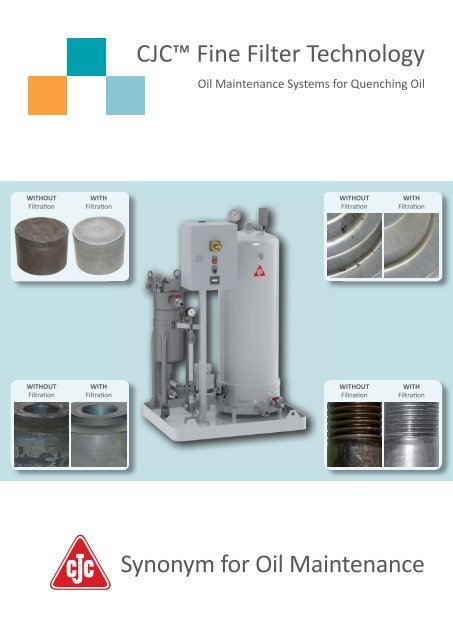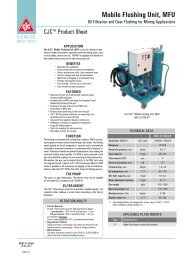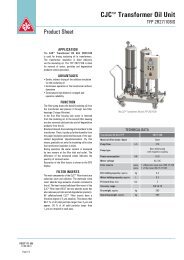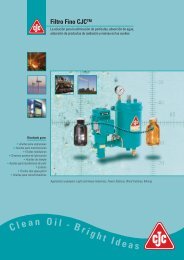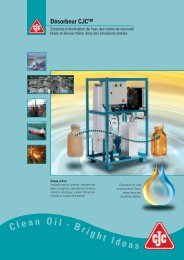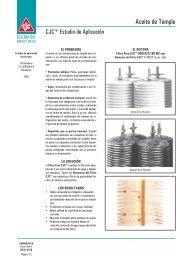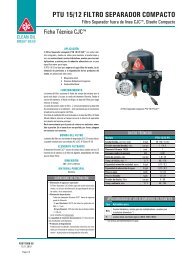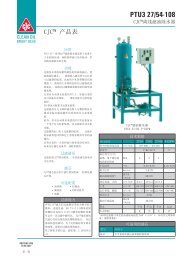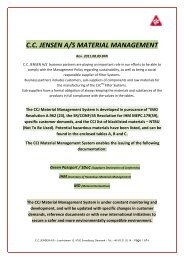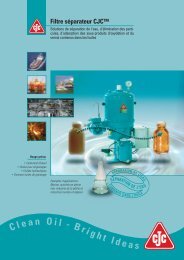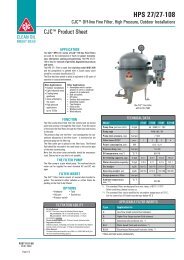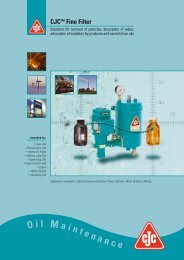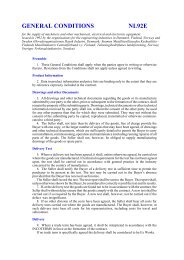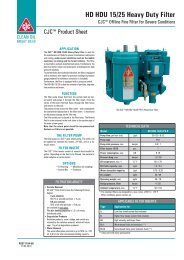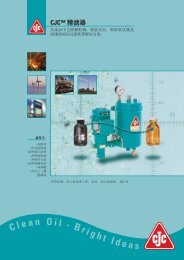CJC™ Fine Filter Technology for Quenching Oil - Cjc.dk
CJC™ Fine Filter Technology for Quenching Oil - Cjc.dk
CJC™ Fine Filter Technology for Quenching Oil - Cjc.dk
You also want an ePaper? Increase the reach of your titles
YUMPU automatically turns print PDFs into web optimized ePapers that Google loves.
CJC <strong>Fine</strong> <strong>Filter</strong> <strong>Technology</strong><br />
<strong>Oil</strong> Maintenance Systems <strong>for</strong> <strong>Quenching</strong> <strong>Oil</strong><br />
WITHOUT<br />
Filtration<br />
WITH<br />
Filtration<br />
WITHOUT<br />
Filtration<br />
WITH<br />
Filtration<br />
WITHOUT<br />
Filtration<br />
WITH<br />
Filtration<br />
WITHOUT<br />
Filtration<br />
WITH<br />
Filtration<br />
Synonym <strong>for</strong> <strong>Oil</strong> Maintenance
Contaminations in <strong>Quenching</strong> <strong>Oil</strong><br />
Contaminations in quench baths<br />
Quench oils are exposed to an extremely high ingress of dirt.<br />
Cracking products<br />
Thermal strain during<br />
quench process<br />
(e. g. asphaltenes)<br />
Particles<br />
Carbon - via quench process<br />
Cinder - via quenched parts<br />
Dust - from the environment<br />
Water<br />
Condensation and leakages<br />
Cover paste<br />
Ingress via quenched parts<br />
Worse quenching results<br />
Deposits<br />
Black deposits on quenched<br />
parts, coolers, circulating<br />
systems and aqua-alarmsystems<br />
Contaminations<br />
in the quench bath<br />
influence the cooling curve,<br />
the critical cooling time and<br />
there<strong>for</strong>e the quenching<br />
result respectively the<br />
material quality<br />
Cooling curve<br />
Unevenly extended vapour<br />
phase, foam <strong>for</strong>mation, risk<br />
of splashing<br />
Sludge accumulation<br />
in tanks, deposits on parts’<br />
surfaces<br />
High per<strong>for</strong>mance quenching oil<br />
Waterfree<br />
Water content 0.2 %<br />
Water content 0.5 %<br />
Test piece 10 mm ø<br />
Cinder resistent material<br />
Without circulation<br />
Test temperature 50 °C<br />
Temperature in °C<br />
Cooling time in seconds<br />
Influence on costs and quality<br />
After-treatment<br />
Additional cleaning, high<br />
dirt load of the washing<br />
baths<br />
Blasting and grinding<br />
processes<br />
are cost and labour<br />
intensive, overheating of<br />
the parts<br />
Surface quality<br />
deteriorates, risk of fire<br />
increases<br />
Maintenance<br />
and costs increase<br />
UNFILTERED<br />
quench bath<br />
Bushing<br />
Valve cover<br />
Semifinished<br />
product<br />
Screw<br />
2<br />
FILTERED<br />
quench bath
CJC <strong>Fine</strong> <strong>Filter</strong> Insert<br />
Particles<br />
Depth filter inserts - plenty of space <strong>for</strong> contamination<br />
75 % of the insert volume <strong>for</strong>ms a structure of cavities. Even the smallest<br />
particles are retained from the oil in this maze-like, small-pored meshed filter<br />
material. Each insert has a filtration degree of 3 µm absolute (1 µm nominal).<br />
Depending on density and size, several kilos of dirt can be retained until the<br />
CJC <strong>Fine</strong> <strong>Filter</strong> insert is saturated.<br />
Water<br />
Learning from the nature - each fibre absorbs water<br />
The natural cellulose fibres of the CJC <strong>Fine</strong> <strong>Filter</strong> insert absorb water and<br />
retain it permanently. Even if only a few ppm of water are in the oil, the fibres<br />
dry the oil, provided the flow of the fluid through the filter material is sufficiently<br />
slow (except: aqueous quenching media). Already the smallest size of<br />
the filters has got an absorption capacity up to several litres (max. 33.6 L).<br />
Asphaltenes<br />
184 soccer fields - a lot of space <strong>for</strong> docking<br />
Asphaltenes and other oil degradation products are polar - there<strong>for</strong>e, they<br />
can be removed by cellulose. Due to their molecular structure, cellulose<br />
fibres have countless polar sites. With a combination of adsorption and<br />
absorption, the oil degradation products are drawn from the oil and held<br />
back permanently. Cellulose fibres have an inner surface of 150 m² per 1<br />
gram; with a weight of 9.2 kg, filter elements of the smallest size there<strong>for</strong>e<br />
offer a surface that equals more than 184 soccer fields. In addition, a<br />
considerable amount of dirt will deposit on the outside of the filter element.<br />
Cellulose fibre composite<br />
(CJC <strong>Fine</strong> <strong>Filter</strong> insert)<br />
Principle<br />
The oil flows through the CJC <strong>Fine</strong> <strong>Filter</strong> insert radially from the outside to<br />
the inside. The micro-fine dirt particles are retained in the depth of the filter<br />
material. Water is absorbed by the cellulose fibres, oil degradation products<br />
deposit on the polar surfaces of the cellulose meshing.<br />
The longer the fluid has contact with the filter material, the more effective<br />
is the fine filtration. For that reason, the depth filter inserts of the CJC <strong>Fine</strong><br />
<strong>Filter</strong> systems have particularly long filter paths.<br />
The filter material has no chemical effect on additives.<br />
Cellulose single fibres<br />
(CJC <strong>Fine</strong> <strong>Filter</strong> insert)<br />
Cross-section of a filter insert<br />
Flow direction<br />
Clean oil<br />
CJC <strong>Fine</strong> <strong>Filter</strong> inserts offer space <strong>for</strong>:<br />
Particles<br />
Water<br />
Asphaltenes<br />
between the fibres<br />
in the fibres<br />
at the fibres<br />
3
Maintenance of <strong>Quenching</strong> Fluids<br />
CJC <strong>Fine</strong> <strong>Filter</strong> systems <strong>for</strong> maintenance of quenching oil are directly connected to the quench bath. The oil highly contaminated<br />
during the quenching process is drawn from the lowest point of the oil bath and after passing through the CJC <strong>Fine</strong> <strong>Filter</strong> insert the<br />
clean oil is pumped back into the oil bath.<br />
Function of a CJC <strong>Fine</strong> <strong>Filter</strong> system<br />
The gear pump draws oil contaminated with particles and water* from the oil bath and passes it slowly and at a constant flow rate<br />
through the CJC <strong>Fine</strong> <strong>Filter</strong> system. The oil flows radially from the outside to the inside through the depth filter insert and returns,<br />
cleaned and dried, to the oil bath. Independently from the quenching process the contents of the oil bath is filtered continuously. The<br />
pressure gauge and the pressure switch signal a necessary filter insert change.<br />
*not <strong>for</strong> aqueous quenching media<br />
Depending on the dirt ingress a prefilter can be installed optionally:<br />
• Bag and sieve basket filter <strong>for</strong> removal of large particles (Item 27a)<br />
• Magnetic and sieve filter <strong>for</strong> removal of cinder and magnetic particles (Item 27b)<br />
9<br />
8<br />
Item<br />
1<br />
Description<br />
<strong>Filter</strong> dome<br />
23<br />
2<br />
<strong>Filter</strong> base<br />
1<br />
8<br />
Automatic bleeding and<br />
venting valve<br />
9<br />
Pressure gauge<br />
27a<br />
27b<br />
11<br />
13<br />
Pump with motor<br />
Non-return valve<br />
15<br />
Pressure switch<br />
20<br />
Base plate<br />
11<br />
15<br />
30<br />
20<br />
25<br />
2<br />
13<br />
23<br />
25<br />
27a<br />
27b<br />
30<br />
Control box<br />
Sampling point<br />
Bag and sieve basket filter<br />
Magnetic and sieve filter<br />
Leakage sensor<br />
4<br />
Cut through used<br />
CJC <strong>Fine</strong> <strong>Filter</strong> insert.<br />
8 up to 56 kg of dirt<br />
Depending on their size CJC <strong>Fine</strong> <strong>Filter</strong> systems<br />
can retain 8 up to 56 kg of dirt be<strong>for</strong>e the CJC <strong>Fine</strong><br />
<strong>Filter</strong> inserts need to be changed.
The Correct Dimensioning<br />
The following drawing shows the various sizes and their modular design.<br />
All CJC <strong>Fine</strong> <strong>Filter</strong> systems are equipped as standard with sampling point, automatic bleeding and venting valve, pressure switch as<br />
well as motor protection switch and shunt release.<br />
[All dimensions in mm]<br />
<strong>Oil</strong> volume<br />
max.<br />
[ l ]<br />
CJC <strong>Fine</strong> <strong>Filter</strong><br />
type<br />
CJC <strong>Fine</strong> <strong>Filter</strong> insert<br />
Volume<br />
[ l ]<br />
CJC <strong>Fine</strong> <strong>Filter</strong> insert JH<br />
up to ISO VG 68 / 40 °C<br />
Surface<br />
[ m² ]<br />
Holding capacity*<br />
Dirt<br />
[ kg ]<br />
Water<br />
[ l ]<br />
Contents<br />
[ l ]<br />
Pump flow<br />
[ l/min ]<br />
Power<br />
consumption<br />
[ kW ]<br />
2,000 27/108 48 4.52 8 4 80 1.5 - 4.5 0.12 - 0.18<br />
4,000 38/100 85 8 15 7.2 125 4.5 - 9 0.18 - 0.25<br />
9,000 427/108 192 18.08 32 16 385 9 - 18 0.25 - 0.37<br />
15,000 727/108 336 31.64 56 28 621 18 - 45 0.37 - 0.75<br />
Subject to technical changes.<br />
*Test dirt: spherical ferrous oxide with prevailing size of 0.5 µm.<br />
The listed types serve as a guideline <strong>for</strong> closed quenching baths. Dimensioning may differ <strong>for</strong> open quench baths due to the higher<br />
dirt ingress. Differing viscosity and temperature can also lead to different system sizes. All systems are available with prefilters. We will<br />
gladly in<strong>for</strong>m you about further optional accessories.<br />
Your customized solution is our standard.<br />
5
Applications<br />
Chamber Furnace<br />
Application Study:<br />
Open quench oil bath<br />
IPSEN Discontinuous chamber furnace, Germany<br />
2,400 litres mineral oil based quenching oil<br />
Problem: Black deposits on hardened parts,<br />
despite extensive after-treatment not removable<br />
Solution: CJC <strong>Fine</strong> <strong>Filter</strong> unit 38/100, filter insert type JH<br />
Result: No deposits on the hardened parts,<br />
(already after<br />
no after-treatment, minimized scrap<br />
1.5 weeks)<br />
Hardened parts:<br />
on the left with unfiltered,<br />
on the right with filtered quenching bath<br />
Application Study:<br />
Open quench oil bath, Finland<br />
40,000 litres quenching oil type Mobiltherm FD<br />
Problem: Irregularities during quenching process due to sludge,<br />
black spots on surfaces<br />
Solution: CJC <strong>Fine</strong> <strong>Filter</strong> unit HDU 3x427/81, filter insert type JH<br />
Result: After only 2 days clean surfaces, oil lifetime increased<br />
by factor 2<br />
First change of filter inserts<br />
Wash water<br />
Application Study:<br />
Washing bath filtration, Germany<br />
400 - 500 litres wash water from the 1st wash tank<br />
Problem: Wash water has to be changed very often, contaminants in<br />
the washing solution re-deposit on the goods<br />
Solution: CJC <strong>Fine</strong> <strong>Filter</strong> unit 27/108, filter insert type BLA<br />
Result: After only a few circulations of the fluid the most of the<br />
contaminants are removed<br />
approx. 30 kg of dirt<br />
after 6 weeks of filtration<br />
Reconditioning of skimmed oil<br />
Application Study:<br />
Continuous quenching line with subsequent washing bath, Germany<br />
4 washing baths each with 1,000 litres<br />
Problem: Drag loss of quenching oil, cost-intensive disposal of the oily washing emulsion,<br />
costly purchase of new oil<br />
Solution: CJC <strong>Filter</strong> Separator 27/108, filter insert type BLAT<br />
Result: Saving of 3,000 litres quenching oil per month (refilling process), i. e. up to 70,000 EUR/year<br />
Hydraulic oil Lubrication oil Gear oil<br />
Motor oil<br />
Diesel / Fuel<br />
Insulating oil Turbine oil<br />
Tap changer oil<br />
Phosphate ester (HFD)<br />
6<br />
Brake fluid Cooling lubricant Silicone oil Water glycole (HFC) Petroleum<br />
Cutting oil Drawing oil Honing oil Rolling oil Lapping oil Thermal oil<br />
Refrigerator oil Compressor oil Drilling oil Rapeseed oil Palm oil
Drying of skimmed <strong>Oil</strong><br />
CJC <strong>Filter</strong> Separatoren<br />
The specially treated CJC <strong>Fine</strong> <strong>Filter</strong> insert type BLAT, retains solid particles as well as oil degradation products without absorbing<br />
water. The water is separated in a subsequent process in the coalescing element.<br />
The coalescing process starts in the CJC <strong>Fine</strong> <strong>Filter</strong> insert. During the<br />
passage through the mesh of cellulose and cotton linters microscopic<br />
water parts combine to droplets.<br />
The water droplets are carried with the laminar oil flow through the<br />
coalescing element and attach to the stainless steel mesh because<br />
of the larger adhesion <strong>for</strong>ces. The flow pushes them along the metal<br />
fibres, lets them combine with other droplets at the intersections and,<br />
due to the higher density, fall into the filter base as larger droplets.<br />
Flow switch and solenoid valve regulate the periodical discharge of the<br />
accumulated water.<br />
CJC Desorber<br />
Larger amounts of water can be discharged with a CJC Desorber. Independently from<br />
additivation and viscosity even stable emulsions can be dried. Depending on the requirement<br />
and dimensioning CJC Desorber can separate 0.2 up to 15 Litres of water per hour.<br />
Function principle<br />
The desorption process is based on the principle that heated air can effectively hold large<br />
quantities of water. In the Desorber, oil preheated to 60 - 85 °C is met by a counter flow of<br />
cold, dry air. The air, heated very quickly by the hot oil, will absorb any water present until<br />
saturation is reached. During the subsequent air cooling process the water condenses and<br />
the dry air is used again <strong>for</strong> drying of the following oil flow.<br />
CJC <strong>Fine</strong> <strong>Filter</strong> unit 27/27<br />
Removal of particles and<br />
oil degradation products,<br />
absorption of water<br />
CJC Desorber D40<br />
Removal of large<br />
amounts of water from<br />
emulsified oils<br />
CJC Cleaning Table<br />
Manual parts cleaning<br />
CJC Fluid Treatment unit 15/25-15/25<br />
Neutralization of acids, removal of<br />
particles, water and oil degradation<br />
products<br />
For each industrial application a suitable solution.<br />
CJC Trans<strong>for</strong>mer <strong>Oil</strong> unit 3R27/108<br />
Drying of trans<strong>for</strong>mer insulation,<br />
insulation is dried indirectly via the<br />
insulating oil<br />
7
- worldwide<br />
Karberg & Hennemann GmbH & Co. KG<br />
Marlowring 5 | D - 22525 Hamburg | Germany<br />
Phone: +49 (0)40 855 04 79 - 0 | Fax: +49 (0)40 855 04 79 - 20<br />
haerten@cjc.de | www.cjc.de<br />
Founded in 1928 and located in Hamburg, we develop and<br />
manufacture CJC <strong>Fine</strong> <strong>Filter</strong> technology since 1951. With<br />
substantiated know-how and in-house analysis and test facilities<br />
we are experts when it comes to the maintenance of oils<br />
and fuels.<br />
Quality<br />
Competent advice and individual solutions, even <strong>for</strong> the most difficult filtration problems<br />
of our customers - that is our daily claim. The certification of our company according to<br />
DIN EN ISO 9001:2008 provides us with assurance and motivation.<br />
CJC worldwide<br />
CJC <strong>Fine</strong> <strong>Filter</strong> systems<br />
are available worldwide<br />
through subsidiaries and<br />
distributors.<br />
Find your nearest<br />
distributor on our website<br />
www.cjc.de.<br />
- Or give us a call!<br />
MPHe | 01.14<br />
Karberg & Hennemann GmbH & Co. KG<br />
www.cjc.de


